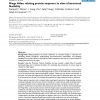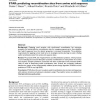44 search results - page 4 / 9 » Prediction of protein structural class using novel evolution... |
BMCBI
2007
13 years 7 months ago
2007
Background: Relating features of protein sequences to structural hinges is important for identifying domain boundaries, understanding structure-function relationships, and designi...
BMCBI
2006
13 years 7 months ago
2006
Background: Designing novel proteins with site-directed recombination has enormous prospects. By locating effective recombination sites for swapping sequence parts, the probabilit...
BMCBI
2008
13 years 7 months ago
2008
Background: Protein remote homology detection and fold recognition are central problems in bioinformatics. Currently, discriminative methods based on support vector machine (SVM) ...
ISMB
1994
13 years 8 months ago
1994
We describe and demonstrate the effectiveness of a method of predicting protein secondary structures, sheet regions in particular, using a class of stochastic tree grammars as rep...
ICML
2005
IEEE
14 years 7 months ago
2005
IEEE
We develop a novel multi-class classification method based on output codes for the problem of classifying a sequence of amino acids into one of many known protein structural class...


